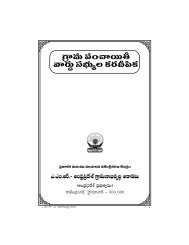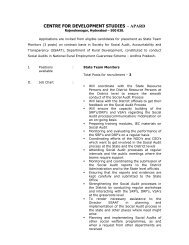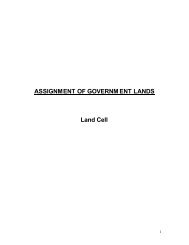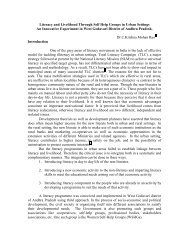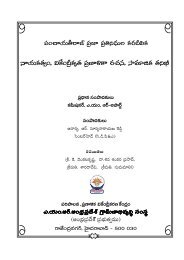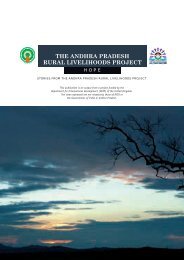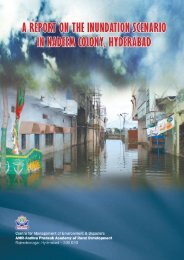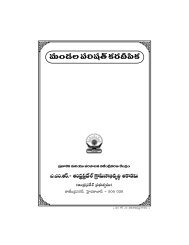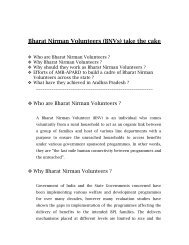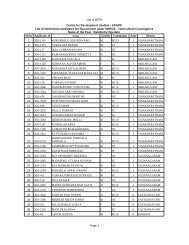April - Andhra Pradesh Academy of Rural Development(APARD)
April - Andhra Pradesh Academy of Rural Development(APARD)
April - Andhra Pradesh Academy of Rural Development(APARD)
Create successful ePaper yourself
Turn your PDF publications into a flip-book with our unique Google optimized e-Paper software.
Suitable time for bee-keeping<br />
Procure boxes from government agencies or noted<br />
companies during <strong>April</strong>. At least four frames full <strong>of</strong> brood,<br />
queen bees and sufficient food stock is necessary.<br />
How to keep boxes in apiary<br />
Always keep boxes in rows. Maintain 1-2 metre<br />
distance between boxes, 3-4 metre distance betweentwo<br />
rows.Keep boxes facingEast.<br />
Inspecting the colonies<br />
Regularly inspect bee colonies. Make changes<br />
according to the bees’ behaviour. While opening boxes,<br />
following precautions must be taken:<br />
1. Check the bees have sufficient food. If they are not<br />
taking food, provide them with artificial food. On an<br />
average, each colony requires 2-5 kilograms <strong>of</strong> food.<br />
2. Check if the queen bee is present. Observe if it is laying<br />
eggs? If not, replace it with another queen bee.<br />
3. Arrange required number <strong>of</strong> frames for laying eggs<br />
and storing nectar.<br />
4. Take measures to protect them from predators and<br />
diseases.<br />
5. Don’t open colonies unless it demands. Don’t disturb<br />
their routine.<br />
How to manage bee colonies<br />
1. Don’t open colonies during extreme weather conditions<br />
2. Open only after you wear bee wheel.<br />
3. Don’t wear dark and black cloths.<br />
4. Don’t go near colonies after applying pungent hair oils.<br />
5. Don’t shake the frames hard.<br />
6. Remove stingwith hive tool when a bee bites you.<br />
@Á|æ˝Ÿ, 2011 kÕúìø£ bÕ\q<br />
7. Take precautions not to injure bees when you fix frames<br />
or remove them<br />
Bee flora and floral calendar<br />
Flowering seasons <strong>of</strong> all available trees and plants in<br />
the nearby places and the availability <strong>of</strong> nectar should be<br />
documented. The plants from which bees collect nectar<br />
are called bee flora. Bee-keepers should select a place<br />
where a good quantity <strong>of</strong> nectar or pollen is easily available.<br />
While selecting an apiary the following information should<br />
be gathered.<br />
1. Bee flora density should be 1-2 kilometres around the<br />
apiary.<br />
2. Assess whether sufficient storage <strong>of</strong> pollen and nectar<br />
is there.<br />
3. Flowering seasons<br />
4. Density <strong>of</strong> flora<br />
According to an estimation, a colony <strong>of</strong> bees requires<br />
100 flowering trees or 2-4 acres <strong>of</strong> crops at flowering<br />
stage to produce 20 kg <strong>of</strong> nectar.<br />
Plants and fields produce nectar and pollen in India:<br />
Acacia, bottle brush, be seam, oaken, citrus cotton,<br />
eucalyptus, jamun, litchi, rubber, robin a, sunflower, Carson,<br />
sesame, soap nut, ton, troika, etc.<br />
Bee-keeping in India is primarily practicedto produce<br />
honey. Bees produce not only honey but also many other<br />
valuable products. By rearing queen bees on a large scale,<br />
we may get good pr<strong>of</strong>its. Bees help in cross pollination<br />
which results in high yield <strong>of</strong> crops. From each colony <strong>of</strong><br />
bees one may earnincome ranging betweenRs. 500 to<br />
Rs.1500, depending on the time and aerial extent.<br />
– V.Lakshminarayana<br />
61




